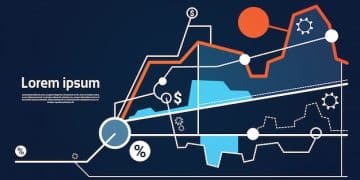Inflation Watch: Protect Your US Business from Rising Costs

Navigating the complexities of current economic shifts requires businesses to proactively implement robust strategies to mitigate the impact of inflation and safeguard their financial stability.
In today’s dynamic economic landscape, businesses across the US are acutely aware of the persistent challenge posed by inflation. Understanding how to effectively navigate this environment and protect your enterprise from the erosion of purchasing power and escalating costs is not merely a financial exercise; it is a strategic imperative for long-term survival and growth. This article delves into actionable strategies, offering a comprehensive guide on Inflation Watch: How to Protect Your Business from Rising Costs in the Current Economic Climate.
understanding inflation’s impact on businesses
Inflation, at its core, represents a sustained increase in the general price level of goods and services in an economy over a period of time. When prices rise, the purchasing power of currency falls, directly impacting both consumers and businesses. For enterprises, this means higher operational costs, from raw materials and energy to labor and transportation. Understanding these fundamental effects is the first step in formulating effective protective measures.
The current economic climate, characterized by various global and domestic factors, has amplified inflationary pressures. Supply chain disruptions, increased consumer demand post-pandemic, and geopolitical tensions have all contributed to an environment where businesses face unprecedented cost escalations. This necessitates a proactive rather than reactive approach to financial management and strategic planning.
identifying key cost drivers
To combat rising costs, businesses must first identify where these increases are originating. This often involves a granular analysis of expenditure across all operational facets.
- Raw Material Costs: Fluctuations in commodity prices directly affect manufacturing and production inputs.
- Labor Costs: Wage increases, driven by labor shortages and calls for higher living wages, are becoming a significant factor.
- Energy Prices: Volatility in oil, gas, and electricity markets impacts production, transportation, and overheads.
- Supply Chain & Logistics: Shipping delays, port congestion, and fuel surcharges elevate delivery expenses.
Without a clear understanding of these drivers, any mitigation strategy would be akin to fighting a fire blindfolded. Regular and detailed financial audits, coupled with market intelligence, become indispensable tools in this process.
The impact of inflation extends beyond direct costs. It can influence consumer spending habits, alter competitive landscapes, and even affect access to credit. Businesses need to consider these broader implications when developing their defensive strategies. A holistic view ensures that measures taken in one area do not inadvertently create vulnerabilities elsewhere. This analytical rigor is vital for maintaining a healthy balance sheet and ensuring operational continuity.
strategic pricing and revenue management
In an inflationary environment, maintaining profitability often requires a keen eye on pricing strategies. Simply raising prices across the board without careful consideration can alienate customers and hand a competitive advantage to rivals. Instead, businesses must adopt sophisticated revenue management techniques that balance cost recovery with market demand and customer value perception.
Value-based pricing, where prices are set primarily on the perceived value to the customer rather than merely on cost plus margin, can be an effective strategy. This approach requires a deep understanding of customer segmentation and what aspects of your product or service they value most. Differentiating your offering can justify higher prices, particularly if your product delivers unique benefits or superior quality that competitors cannot match.
dynamic pricing models
Dynamic pricing, which adjusts prices in real-time based on market demand, supply, and competitor pricing, offers another avenue for revenue optimization. This is particularly relevant for businesses with variable demand or perishable inventory.
- Surge Pricing: Applied during peak demand periods.
- Subscription Models: Offering recurring revenue streams with predictable pricing for customers, while allowing for periodic adjustments.
- Tiered Pricing: Providing different service levels or product features at various price points to capture a wider customer base.
Implementing dynamic pricing effectively requires robust data analytics capabilities and a willingness to experiment. Businesses should monitor customer responsiveness and sales volumes meticulously to fine-tune their pricing algorithms. This adaptability is key to capturing additional revenue without alienating the customer base.
Furthermore, businesses should explore opportunities for unbundling services or products, allowing customers to pay only for what they need, or conversely, offering attractive bundles that provide perceived value at a higher overall price point. The goal is to optimize average revenue per user (ARPU) while carefully managing cost recovery. This strategic approach to pricing helps sustain profitability even as operational costs ascend. It’s about smart revenue maximization, not just simple price increases.
operational efficiency and cost reduction
While strategic pricing addresses the revenue side of the equation, operational efficiency and stringent cost reduction are equally, if not more, critical in combating inflation. Every dollar saved through streamlined processes or reduced waste directly contributes to the bottom line, acting as a buffer against rising external costs. This requires a comprehensive review of all internal operations, from procurement to production and distribution.
Embracing technology often plays a pivotal role in achieving greater efficiency. Automation of repetitive tasks reduces labor costs and minimizes human error. Advanced inventory management systems can optimize stock levels, reducing carrying costs and the risk of obsolescence. Predictive analytics can forecast demand more accurately, preventing overproduction or stockouts that lead to missed sales.
optimizing the supply chain
The supply chain is frequently a major source of cost escalation during inflationary periods. Diversifying suppliers, negotiating long-term contracts with fixed prices, and exploring local sourcing options can mitigate risks associated with global supply chain shocks.
- Supplier Relationships: Foster strong relationships to secure favorable terms and early warnings of price changes.
- Inventory Management: Implement just-in-time (JIT) or optimized inventory strategies to reduce storage and holding costs.
- Logistics Optimization: Consolidate shipments, optimize routes, and explore alternative transportation methods to cut delivery expenses.
Investing in supply chain resilience can yield significant returns when inflation is rampant. This includes conducting regular risk assessments of key suppliers and developing contingency plans for potential disruptions. Proactive engagement with crucial partners helps ensure a more predictable cost environment.

Beyond the supply chain, scrutinize internal processes for inefficiencies. Lean methodologies, such as Six Sigma, can identify and eliminate waste in production and administrative workflows. Employee training focused on resource conservation and efficient practices can also contribute to overall cost savings. The cumulative effect of numerous small efficiencies can be substantial, providing much-needed relief in a high-cost environment.
hedging strategies and financial management
Effective financial management, including the strategic use of hedging instruments, can provide a layer of protection against inflationary pressures. Hedging involves taking a financial position to offset potential losses from adverse price movements. For businesses, this can mean safeguarding against volatile raw material prices, currency fluctuations, or interest rate increases.
Commodity hedging, for example, allows businesses to lock in prices for raw materials they will need in the future, providing certainty in a volatile market. Similarly, currency hedging can protect against unfavorable exchange rate movements if a business deals extensively in international trade. These strategies reduce uncertainty and allow for more accurate financial forecasting, essential for strategic planning.
managing debt and cash flow
Inflation erodes the value of cash and future earnings. Businesses with significant variable-rate debt may see their interest payments rise, further squeezing margins. Prudent financial management during inflation includes:
- Debt Restructuring: Converting variable-rate debt to fixed-rate debt to stabilize interest payments.
- Optimizing Cash Flow: Accelerating receivables collection and extending payables, where feasible, to maximize cash on hand.
- Investing Surplus Cash: Deploying excess cash into short-term, inflation-indexed instruments or asset classes that tend to perform well during inflationary cycles, rather than letting it sit idle and lose value.
Maintaining a strong cash position is paramount. Inflation makes borrowing more expensive and reduces the real value of future revenues. Businesses should prioritize liquidity and solvency, ensuring they have sufficient working capital to manage increased operating expenses without resorting to high-cost financing. Regular cash flow forecasting and stress-testing financial models against various inflationary scenarios are critical practices.
Furthermore, businesses should consider the impact of inflation on their asset valuations. Assets like real estate or intellectual property may appreciate in nominal terms, but their real value needs careful assessment. A comprehensive financial review that accounts for inflationary impacts across all balance sheet items is crucial for a complete picture of financial health.
talent retention and workforce strategies
One of the less immediately obvious, but equally significant, costs of inflation is its impact on human capital. Rising living costs reduce employees’ purchasing power, leading to demands for higher wages and benefits. Failure to address these concerns can result in increased employee turnover, talent shortages, and a decline in morale and productivity, all of which incur substantial indirect costs for the business.
In an inflationary climate, compensation strategies need to be reevaluated. This doesn’t necessarily mean across-the-board pay raises that could further strain finances. Instead, businesses can explore a combination of flexible compensation, performance-based incentives, and non-monetary benefits that improve employee well-being and loyalty.
innovative compensation and benefits
To retain key talent and attract new hires without breaking the bank, consider diversified approaches:
- Performance Bonuses: Tying additional compensation to business or individual performance, ensuring pay increases are linked to productivity.
- Non-Monetary Perks: Offering benefits like flexible work arrangements, professional development opportunities, or improved health and wellness programs.
- Inflation-Indexed Adjustments: Rather than large, infrequent raises, smaller, more frequent cost-of-living adjustments tied to inflation metrics for specific roles.
Investing in employee engagement and development is also a powerful retention tool. Employees who feel valued, challenged, and have opportunities for growth are less likely to seek opportunities elsewhere, even in the face of inflationary pressures. This strategic investment in human capital protects a valuable asset and ensures business continuity.

Beyond compensation, fostering a positive work culture and providing clear communication about the company’s strategies to navigate inflation can help alleviate employee anxiety. Transparency builds trust and encourages employees to contribute to cost-saving and efficiency efforts. A well-informed and engaged workforce is better equipped to adapt to economic challenges and contribute to collective solutions, making them a crucial line of defense against inflationary impacts.
leveraging technology and innovation
Technology and innovation offer powerful tools for businesses looking to combat inflation by increasing efficiency, reducing costs, and creating new revenue streams. The rapid pace of technological advancement means that solutions once considered cutting-edge are now becoming mainstream, making them accessible even to small and medium-sized enterprises. Embracing these tools is no longer an option but a necessity for competitive survival.
From automating back-office functions and customer service to optimizing production processes with AI and machine learning, digital transformation can drive significant cost savings. For example, cloud computing reduces infrastructure costs, while data analytics provides insights that lead to better decision-making and resource allocation. These investments, while requiring initial capital, often yield substantial long-term returns, helping to insulate businesses from inflationary pressures.
exploring new business models and markets
Innovation extends beyond internal processes to encompass fundamental changes in how a business operates and generates revenue. This might involve:
- Subscription Services: Shifting from one-time sales to recurring revenue models for greater predictability and customer loyalty.
- Digital Transformation: Moving traditional services online to reduce physical overheads and expand market reach.
- Waste Reduction & Circular Economy: Implementing practices that minimize waste and maximize resource utilization, which can lead to significant cost savings on materials and disposal.
- Product/Service Diversification: Introducing new offerings that cater to evolving customer needs or tap into less inflation-sensitive market segments.
These innovative approaches not only help combat inflation but can also unlock new growth opportunities. By proactively adapting their business models and exploring new markets, companies can build resilience and achieve sustainable growth. The ability to innovate rapidly and adapt to changing economic conditions is a hallmark of successful businesses in any era, but particularly during periods of high inflation.
Businesses should foster a culture of continuous improvement and experimentation. Encouraging employees to identify areas for innovation and empowering them to test new ideas can lead to breakthrough solutions. This agility and forward-thinking mindset are critical in an economic environment where static approaches quickly become obsolete. Leverage technology to not only cut costs but also to enhance customer experience and create compelling new value propositions.
government support and advocacy
While much of the inflation mitigation responsibility lies with individual businesses, understanding and leveraging available government support programs and participating in industry advocacy can provide additional avenues for relief and influence. Governments often implement policies and initiatives aimed at softening the blow of economic downturns or inflationary spikes, and businesses should be aware of these resources.
This includes various economic stimulus packages, tax credits for specific investments (e.g., in renewable energy or job creation), or grants for research and development. Accessing these programs can reduce a business’s operational costs or provide capital for investments that enhance efficiency and competitiveness. Keeping abreast of federal, state, and local government announcements is crucial for identifying applicable opportunities.
industry associations and lobbying
Beyond direct government aid, businesses can find strength in numbers by joining industry associations. These organizations often advocate on behalf of their members for policies that can alleviate inflationary pressures, such as:
- Trade Policies: Advocating for tariffs or trade agreements that lower import costs or protect domestic industries.
- Regulatory Reform: Pushing for de-regulation or simplified processes that reduce compliance costs.
- Fiscal Policy: Lobbying for government spending or taxation policies that are conducive to business growth and stability during inflationary periods.
- Skills Training & Workforce Development: Partnering with governmental and educational institutions to address labor shortages and skill gaps, which can lead to wage inflation.
Active participation in these discussions allows businesses to voice their concerns and contribute to shaping a more favorable economic environment. Collective action can often achieve results that individual businesses cannot accomplish alone. Regularly engaging with policymakers and industry peers creates a powerful platform for addressing systemic challenges.
Understanding the interplay between government policy, economic trends, and business operations is key. Businesses should consider allocating resources to monitor policy changes and engage with representative bodies. This proactive engagement ensures that their interests are heard and factored into decisions that directly affect their financial health and ability to withstand inflationary pressures, contributing to a more resilient economic ecosystem for all.
| Key Strategy | Brief Description |
|---|---|
| 📈 Dynamic Pricing | Adjust prices in real-time based on demand, supply, and competitor pricing to optimize revenue. |
| ⚙️ Operational Efficiency | Streamline processes, reduce waste, and leverage technology to lower operating costs. |
| 💲 Financial Hedging | Utilize financial instruments to lock in future costs and protect against market volatility. |
| 👨👩👧👦 Talent Retention | Implement innovative strategies to retain skilled workforce amidst rising living costs. |
frequently asked questions about protecting businesses from inflation
The primary impact of inflation on small businesses is a significant increase in operating costs, including raw materials, labor, and transportation. This reduces profit margins and can strain cash flow, making it challenging to maintain solvency. Small businesses, often with less financial flexibility than larger corporations, feel these pressures acutely and must adapt quickly to survive.
Businesses can effectively pass on costs by implementing value-based pricing, highlighting the unique benefits or superior quality of their offerings. Additionally, using dynamic pricing models, offering tiered services, or unbundling products can provide customers with choices, softening the impact of price increases while allowing the business to recover some of its rising expenses. Transparency about cost pressures can also help.
Technology plays a critical role in mitigating inflationary effects by driving operational efficiency and reducing costs. Automation of tasks, optimizing supply chains through analytics, and using cloud computing can significantly lower expenses. Furthermore, technology enables flexible business models, like e-commerce or subscription services, which can enhance revenue streams and adapt more dynamically to market changes.
Yes, businesses can utilize various financial instruments to hedge against inflation. These include commodity futures contracts to lock in raw material prices, currency forward contracts to mitigate exchange rate risks, and interest rate swaps to convert variable-rate debt to fixed-rate debt. Investing surplus cash in inflation-indexed bonds (TIPS in the US) can also protect against the erosion of purchasing power.
Employee retention is crucially important during high inflation because rising living costs can lead to increased turnover as employees seek higher wages. Losing skilled staff results in significant recruitment, training, and productivity loss costs. Businesses must offer competitive compensation packages, including non-monetary benefits and a positive work environment, to retain talent and minimize these indirect financial burdens.
conclusion
Navigating an inflationary economic climate demands a multifaceted and adaptive approach from businesses. There is no single magic bullet; rather, a combination of strategic pricing, relentless focus on operational efficiency, prudent financial management, and innovative talent strategies forms the bulwark against rising costs. By proactively monitoring economic indicators and implementing the strategies outlined, businesses can not only survive but potentially thrive amidst inflationary pressures, safeguarding their financial health and ensuring long-term sustainability.





